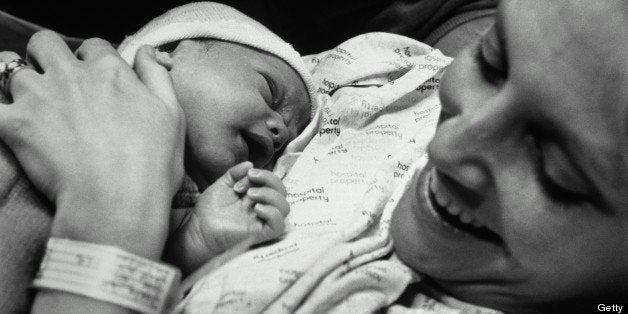
For many parents, cutting the umbilical cord is a memorable moment in the breathless seconds after their baby is born.
But a new scientific review suggests that delaying cord clamping by even one minute increases an infant's iron stores for up to six months.
When babies are born, they are still attached to their mothers by the umbilical cord, which delivers nutrients and oxygen throughout pregnancy. The cord is typically clamped both near the baby's navel and farther down, then snipped in between, leaving behind a small stump that falls off usually within several weeks.
In the new review, published on The Cochrane Database, researchers analyzed 15 trials from several countries, each weighing the merits of early cord clamping (within the first 60 seconds after a baby is delivered) and later clamping (more than one minute after birth). The studies included both vaginal and caesarean deliveries.
The practice of immediate cord clamping developed in part because physicians felt it reduced the risk of mothers hemorrhaging, but the new review found that delayed clamping did not increase such risks.
And waiting a minute or two to clamp the cord does have several health benefits for babies, including higher hemoglobin levels in the days immediately after birth and increased iron reserves up to six months later.
"Breast milk has very little iron in it. Nature intended for babies to get their iron from placental transfusion," explained Dr. Mark Sloan, a pediatrician and author of Birth Day: A Pediatrician Explores the Science, the History, and the Wonder of Childbirth. "From the [obstetrician's] perspective, it makes very little difference to their practice whether they clamp early or late, but for a baby from birth to 6 months of age, it does."
Previous studies have suggested that waiting to cut the cord increases babies' risk for jaundice, or yellowing of a baby's skin and eyes, and the Cochrane review did find a slight increase in the number of babies who needed to be treated for the condition. But overall, it concluded that a more liberal approach to delaying umbilical cord clamping in newborns is warranted.
An 2012 opinion from the American College of Obstetricians and Gynecologists was more cautious in its interpretation, saying that the ideal time for clamping the cord has not yet been established, but that several reviews have found that delaying is beneficial, particularly among pre-term babies, when possible.
Presently, immediate cord clamping is more commonly practiced, said Dr. Jeffrey Ecker, director of obstetrical clinical research and quality assurance at Massachusetts General Hospital and the chair of obstetrics practice with ACOG.
"Over time, I believe we'll see an evolution in practice with appropriate women and babies -- babies that don't otherwise need immediate attention," Ecker said. "I don't think it is all going to change in a year. But in five, 10 years, we'll look back and say, 'Boy, this is different.'"
"Basic practice habits are often formed in school and residency, and can take a while to change," echoed Sloan. He said that parents who want to delay cord clamping should feel empowered to discuss it with their doctors, midwives and nurses.
In recent months, the practice of "lotus birth," or letting the umbilical cord fall off naturally after birth, has grabbed media headlines. The cord typically separates from the baby's belly button within three to 10 days, one lotus birth website states, and "enables baby, mother and father and all family members to pause, reflect and engage in nature's conduct."
But the Cochrane review endorsed delaying cord clamping within a matter of minutes, not avoiding it altogether. To date, no scientific studies have backed the practice of waiting for umbilical cord to fall off on its own, said Sloan.
"The main benefit [to delayed clamping] is increased iron to the baby," he added. "That is done by three minutes or so."